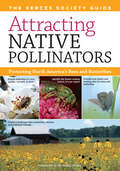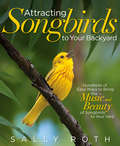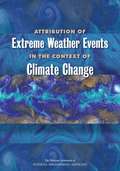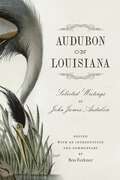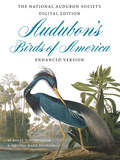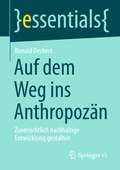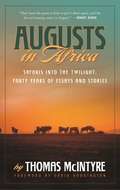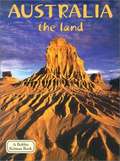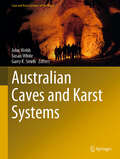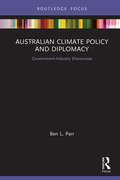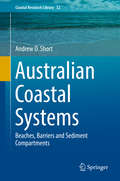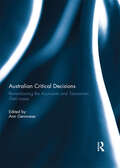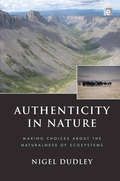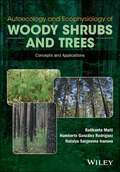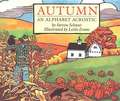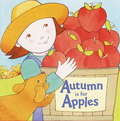- Table View
- List View
Attracting Native Pollinators: The Xerces Society Guide to Conserving North American Bees and Butterflies and Their Habitat
by The Xerces Society Dr Marla SpivakWith the recent decline of the European honey bee, it is more important than ever to encourage the activity of other native pollinators to keep your flowers beautiful and your grains and produce plentiful. In Attracting Native Pollinators, you’ll find ideas for building nesting structures and creating a welcoming habitat for an array of diverse pollinators that includes not only bees, but butterflies, moths, and more. Take action and protect North America’s food supply for the future, while at the same time enjoying a happily bustling landscape.
Attracting Songbirds to Your Backyard: Hundreds Of Easy Ways To Bring The Music And Beauty Of Songbirds To Your Yard
by Sally RothThe best ways to attract melodic birds, with insight into their rapidly changing habits The American robin and northern cardinal are two of the best-loved songbirds, but newer backyard arrivals, like rose-breasted grosbeaks and scarlet tanagers, quickly captivate with their vivid colors and unique songs. Bird lovers will learn to attract new visitors by offering treats that songbirds like best, such as soft, easy-to-peck foods that closely mimic caterpillars, their top food preference. And planting just a few carefree perennials and shrubs can provide opportunities for cover and nesting. Sally Roth's Attracting Songbirds to Your Backyard draws on the latest science and 50 years of observation to reveal these fascinating details: • In the wee hours, it's the robins that sing first, followed by the babble of house wrens and the whistle of cardinals • Some birds learn birdsongs throughout their lives, while others stop learning once they can mimic their parents' song • It's Dad, not Mom, who teaches the young birds to sing Simple tips, ideas, and recipes, as well as an understanding of why songbirds are coming from the treetops into the backyard, will help any bird enthusiast create a songbird sanctuary.
Attracting Sustainable Investment: A Professional Guide
by Saskia VanderbentThis book is a practitioner’s guide to sustainable development, laying out strategies for attracting investment for communities and their partners. It proposes an innovative Sustainable Development Proposition (SDP) decision-making tool based on a propositional calculus that can be used to analyse the sustainability of an infrastructure investment. It draws on environmental sustainability governance data analysis enabling investors to understand the economic indicators, income potential, return on investment, demand and legal compliance, as well as community and social benefits. Identified risks, issues and advantages are managed and monitored, and the SDP guidance can be applied to improve the prospects of the project in order to attract investment. Sustainable Community Investment Indicators (SCIIs™) have been developed to assist with attracting investment and monitoring feedback on infrastructure projects, designed by the author for remote rural and indigenous communities – in response to current industry tools that are designed for urban environments. The book includes a broad range of real-world and hypothetical case studies in agricultural and indigenous areas in South America, Europe, Africa, Asia, Australia and the Pacific. Taking a diverse economies approach, these industry tools can be adapted to allow for enterprise design with unique communities. This book provides sustainable development practitioners, including government agencies, financiers, developers, lawyers and engineers, with a positive, practical guide to addressing and overcoming global issues with local and community-based solutions and funding options.
Attribution of Extreme Weather Events in the Context of Climate Change
by Engineering Medicine National Academies of SciencesAs climate has warmed over recent years, a new pattern of more frequent and more intense weather events has unfolded across the globe. Climate models simulate such changes in extreme events, and some of the reasons for the changes are well understood. Warming increases the likelihood of extremely hot days and nights, favors increased atmospheric moisture that may result in more frequent heavy rainfall and snowfall, and leads to evaporation that can exacerbate droughts. Even with evidence of these broad trends, scientists cautioned in the past that individual weather events couldn’lt be attributed to climate change. Now, with advances in understanding the climate science behind extreme events and the science of extreme event attribution, such blanket statements may not be accurate. The relatively young science of extreme event attribution seeks to tease out the influence of human-cause climate change from other factors, such as natural sources of variability like El Niño, as contributors to individual extreme events. Event attribution can answer questions about how much climate change influenced the probability or intensity of a specific type of weather event. As event attribution capabilities improve, they could help inform choices about assessing and managing risk, and in guiding climate adaptation strategies. This report examines the current state of science of extreme weather attribution, and identifies ways to move the science forward to improve attribution capabilities.
Audubon on Louisiana: Selected Writings of John James Audubon
by Ben ForknerAlthough we remember John James Audubon’s years in Louisiana primarily for the art he produced there, his writings reflect the profound impact the region made on him and his artistic vision, especially in his magnificent collection of paintings published as The Birds of America. In Audubon on Louisiana, Ben Forkner compiles and explains in depth Audubon’s essential writings on the region. Beginning in 1810 as Audubon arrives in the upper Louisiana Territory, and continuing as he moves into southern Louisiana ten years later (and eventually brings his wife, Lucy, to join him), Audubon’s journals, essays, and letters reveal his struggles to fill his portfolio with new watercolors, his discoveries throughout the region, and the transformative effect the area had on both his art and his life.Forkner provides a detailed introduction to Audubon’s private journal of 1820–21, the Louisiana Journal, to guide readers through this compelling document. Until now, the difficulty of comprehending Audubon’s rough English has often kept readers from fully appreciating the Journal’s significance. The volume also contains a dozen essays that Audubon penned about his experiences in Louisiana; most of these “episodes” he published in his Ornithological Biography, a massive five-volume written work that complements the visual art of Birds of America. Letters describing Audubon’s last voyage to Louisiana in 1837 followed by nine of his Louisiana bird biographies round out the collection. These original texts, augmented with Forkner’s commentary, form a magisterial work that illuminates the importance of Louisiana to Audubon’s life and art. Audubon on Louisiana deepens appreciation of one of the most significant artists—and nature writers—of the nineteenth century.
Audubon's Birds of America: The National Audubon Society Digital Edition, Enhanced Version (Tiny Folio Ser.)
by Roger Tory Peterson Virginia Marie PetersonEven before its completion in 1839, John James Audubon's Birds of America was recognized as a masterpiece of both art and natural science; a great scientist of the day called it the "most magnificent monument which has ever been raised to ornithology."Roger Tory Peterson and Virginia Marie Peterson's modern edition of the Birds of America, published with the full endorsement and cooperation of the National Audubon Society, is itself an acknowledged classic. Now, for the first time, it is available as an e-book.All 435 of Audubon's brilliant hand-colored engravings are presented in exquisite reproductions derived from the Audubon Society's own archival copy of the rare Double Elephant Folio. A generously illustrated introduction surveys Audubon's career, as well as the history of American bird art before and after him. Descriptive captions, hyperlinks to authoritative species profiles, and a new, scientifically based arrangement of the prints allow us to appreciate Audubon's achievement in the light of modern ornithology.This enhanced version of the e-book also features high-quality embedded recordings of birdcalls from the Cornell Lab of Ornithology's Macaulay Library.
Auf dem Weg ins Anthropozän: Zuversichtlich nachhaltige Entwicklung gestalten (essentials)
by Ronald DeckertAuf dem Weg vom Holozän ins aufkommende Zeitalter des Anthropozäns zeichnen sich essenzielle und existenzielle Herausforderungen für die Menschheit ab. Der Weg in Richtung einer nachhaltigeren Zukunft braucht bei wissenschaftlicher Grundlegung und Interdisziplinarität vor allem tatkräftiges Engagement vieler Menschen auf allen Ebenen. Hierfür zeigt das essential Orientierungslinien auf.
Augury: Poems
by Eric PankeyFrom award-winning poet and author of Crow-Work, a collection exploring the presence of the divine in the seemingly ordinary. The ancient Romans practiced augury, reading omens in bird&’s flight patterns. In the poems of Augury, revelation is found in nature&’s smallest details: a lizard&’s quick movements, a tree scarred by lighting, the white curve of a snail&’s shell. Here the sensory world and the imagined one collide in unexpected and wonderful ways, as Pankey scrutinizes the physical for meaning, and that meaning for truth. With uncommon grace, each of Pankey&’s precise lyrics advances our shared ontological questions and expresses our deepest contradictions. In a world of mystery, should we focus on finding meaning or creating it? How can the known—and the unknown— be captured in language?Augury is a masterful and magical collection from a poet of stirring intelligence, &“a book of stones unstitched from the wolf&’s belly.&”Praise for Augury &“A darkly luminous book by a poet at the height of his considerable poetic power.&” —Kathy Fagan, author of Moving & St. Rage &“This is a book I will keep close at hand, alongside the best work of Montale, Dickinson, Celan, and Stevens. This is a book one will turn to again and again.&” —Rebecca Dunham, author of Cold Pastoral &“Each ethereal image he weaves into his work is delicately curated, whittled down through his attention to sound. . . . Pankey&’s poems destabilize as they straddle time and place, and he looks askance at the narrow way in which language is often viewed.&” —Publishers Weekly
August Magic (Summer #3)
by Katherine ApplegateThis trilogy from Ocean City author Katherine Applegate concludes this month. Seventeen-year-old Summer Smith's three glorious months in the Florida Keys are coming to an end. With only a short time left, can she find her true love and make him hers, or does the end of vacation mean the fun--and the romance--is over?
Augusts in Africa: Safaris into the Twilight: Forty Years of Essays and Stories
by Thomas Mcintyre Craig Boddington Andrew Warrington"They burn the grass in July to get it short again, and the decent hunting starts in August." -Robert RuarkAmericans from Roosevelt to Hemingway to Ruark to Capstick to Robert Jones defined Africa in ways that no European colonist ever would or could. In Augusts in Africa, Thomas McIntyre presents the stories he has gathered from four decades of safari-ing in Africa-and from among the most transforming days, weeks, and months of his life.For those who know it well, these tales may read like accurate reflections of their own experiences on the continent. For others who have journeyed to Africa only briefly, or even not at all, there is a transporting insight to be found in them. And if there is more than one account on the hunting of the Cape buffalo, that is only because it, the buffalo, may simply represent the ideal combination (the "perfect game") of size, strength, intelligence, and vehemence to be found in any large wild animal and is therefore indicative of what draws us back again and again to Africa.Whether crouched in a blind for hours until he can clearly make out the individual rosettes on a leopard's hide or listening to the professional hunter utter "Oh oh, you should run" when faced with a charging elephant cow, Tom McIntyre brings to life amazing African animals and exciting expeditions in Augusts in Africa.
Aurora: The Mysterious Northern Lights
by Candace SavageExplore the Myth and Science Behind the Aurora Even those who have not had the privilege of seeing aurora know that there is something magical about them. Throughout the ages, the sheer magnificence and eerie grandeur of the northern lights have evoked both fear and wonder. But few of us understand why or how they occur. As beguiling as the auroral legends are, the scientific explanation for the lights is no less awe-inspiring. In a clear, intelligent text that is accompanied by dozens of archival illustrations, diagrams, and color photographs, Candace Savage explores the myth and science behind the aurora. She reveals the surprisingly common threads in the auroral traditions of distant cultures and follows the long, colorful, and sometimes fractious path that led scientists to the contemporary theory about the lights. Candace Savage is the author of numerous internationally acclaimed books of natural history, including Wolves, Grizzly Bears, Wild Cats and Bird Brains: The Intelligence of Crows, Ravens, Magpies and Jays. Her large body of work has been honored by the American and Canadian Library Associations, the Canadian Science Writers' Association and the Rachel Carson Institute. She lives in Saskatoon, Saskatchewan.
Austral Ark
by Norman Maclean Adam Stow Norman Maclean Gregory I. Holwell Adam StowAustralia and New Zealand are home to a remarkable and unique assemblage of flora and fauna. Sadly though, by virtue of their long isolation, and a naïve and vulnerable biota, both countries have suffered substantial losses to biodiversity since European contact. Bringing together the contributions of leading conservation biologists, Austral Ark presents the special features and historical context of Austral biota, and explains what is being conserved and why. The threatening processes occurring worldwide are discussed, along with the unique conservation problems faced at regional level. At the same time, the book highlights many examples of conservation success resulting from the innovative solutions that have been developed to safeguard native species and habitats in both New Zealand and Australia. Austral Ark fills an important gap regarding wildlife gains and declines, and how best to take conservation forward to keep this extraordinary area of the world thriving.
Australia: The Land (Lands, Peoples, and Cultures)
by Erinn BantingEarth did not always look as it does today. Hundreds of millions of years ago, it was covered by one enormous landmass called Pangaea. About 200 million years ago, Pangaea began to split in two. Slowly, the two pieces drifted farther apart and split into even more pieces. Eventually, the seven continents formed: North America, South America, Europe, Asia, Africa, Australia, and Antarctica. Australia and Antarctica drifted the farthest south, into the southern hemisphere.
Australian Caves and Karst Systems (Cave and Karst Systems of the World)
by Susan White John Webb Garry K. SmithThis book, part of the series Cave and Karst Systems of the World, begins with a review of the interaction between people and caves in Australia (including conservation), followed by descriptions of the spectacular cave diving sites, before comprehensively covering all the major carbonate and noncarbonate karst areas, subdivided by rock type and region, and including the origin of the caves. This is followed by broad overviews of cave minerals and speleothems, cave biology and cave fossils. Each section was written by one or more specialists in the topic and is illustrated by clear diagrams and superb colour photos. The book emphasises the unique aspects of the Australian karst, including the variability in the age of the caves (very old to very young) and the impact of isolation on the stygofauna, as well as the vertebrate fossils preserved in the caves. Written in an easy-to-read style, the book is a primary reference guide to Australian karst and represents a valuable asset for anyone interested in the topic, not only cavers and academics.
Australian Climate Law in Global Context
by Jacqueline Peel Alexander Zahar Jacqueline Peel Lee Godden Alexander ZaharAustralian Climate Law in Global Context is a comprehensive guide to current climate change law in Australia and internationally. It includes discussion of: emission trading schemes and carbon pricing laws, laws on renewable energy, biosequestration, carbon capture and storage and energy efficiency; the trading of emission offsets between developed and developing countries, the new international scheme for the protection of forests (REDD) and the transfer of green finance and technology from developed to developing states, the adaptation to climate change through legal frameworks. It assesses the international climate change regime from a legal perspective, focusing on Australia's unique circumstances and its domestic implementation of climate-related treaties. It considers how the challenge of climate change should be integrated into broader environmental law and management. It is a valuable resource for students in law and environmental science, for current and future legal practitioners and for policy-makers and those in the commercial sector.
Australian Climate Policy and Diplomacy: Government-Industry Discourses (Routledge Focus on Environment and Sustainability)
by Ben L. ParrAustralian Climate Policy and Diplomacy provides a well overdue critique of existing, and high-profile, publications that convey the ‘greenhouse mafia’ hypothesis, which posits that Australia’s weak policy response to climate change is the result of a menacing domestic fossil fuel lobby. Ben L. Parr argues that the shared government–industry discourse about protecting Australia’s industrial competitiveness has had a more decisive influence in shaping and legitimising Australian climate policy than the direct lobbying tactics of the fossil fuel industry. Parr also reveals how the divergent foreign policy discourses and traditions of Australia’s two major political parties – as internationalist versus alliance-focused – have enabled and constrained their climate diplomacy and domestic policies over time. To demonstrate his argument, he presents a discourse analysis woven into a chronological policy narrative, comprising more than 1000 primary texts (media releases, interviews, and speeches) generated by prime ministers and key fossil fuel lobbyists. Overall, this volume illustrates how domestic forces have and are influencing Australia’s climate policy. In doing so, it also provides a framework that can be adapted to examine climate mitigation policies in other countries, notably Canada and the US. This book will be of interest to students and scholars of climate change, environmental policy and governance, and Australian climate change policy and politics more specifically, as well as policymakers and practitioners working in these fields.
Australian Coastal Systems: Beaches, Barriers and Sediment Compartments (Coastal Research Library #32)
by Andrew D. ShortThis book describes the entire coast and beaches and barrier systems of Australia. It covers the coastal processes and systems that form and impact Australia's 30.000 km coast, 12.000 beaches and 2750 barrier systems. These processes include geology, geomorphology, climate, waves, tides, currents, sediment supply, as well as coastal ecosystems. The coast is divided into tropical northern and southern temperate provinces, within which are seven divisions, 23 regions and 354 coastal sediment compartments each of which is described in detail in the 34 chapters. Within these systems are the full range of wave through tide-dominated beaches and barriers ranging from cheniers to massive transgressive dune systems together with a range of onshore and longshore sand transport systems. This is an up to date reference for the entire coast, its present condition and likely responses to the impacts of climate change.
Australian Critical Decisions: Remembering Koowarta and Tasmanian Dams
by Ann GenoveseThe 1980s was a time of significant social, political and cultural change. In Australia law was pivotal to these changes. The two High Court cases that this book explores- Koowarta v Bjelke-Petersen in 1982 and the Tasmanian Dams case in 1983- are famous legally as they marked a decisive reckoning by the Court with both international law and federal constitutionalism. Yet these cases also offer a significant marker of Australia in the 1980s: a shift to a different form of political engagement, nationally and internationally, on complex questions about race, and the environment. This book brings these cases together for the first time. It does so to explore not only the legal legacy and relationship between Koowarta and Tasmanian Dams, but also to reflect on how Australians experience their law in time and place, and why those experiences might require more than the usual legal records. The authors include significant figures in Australian public life, some of whom were key participants in the cases, as well as established and respected scholars in law, history, Indigenous and environmental studies. The book offers a combination of personal recollections of the cases- the drama of how they were brought before the courts and decided- as well as a consideration of the cases’ ongoing significance in Australian life. This book was previously published as two special issues in the Griffith Law Review.
Authenticity in Nature: Making Choices about the Naturalness of Ecosystems
by Nigel DudleyThis book examines the concept of naturalness in ecosystems, discusses its values and considers choices about the level of naturalness in conservation efforts. The author argues that all ecosystems have been modified and the idea of places 'untouched by humans' is a myth. But there are large differences in the degree of modification and levels of naturalness which can be identified. Changes are not always irreversible; some apparent wilderness areas are sites of former civilizations. There is no longer any simple distinction possible between 'natural' and 'cultural' systems. In the future, society will, to some extent, choose the degree of naturalness in land and seascapes. The growth of protected areas is an early sign of this, as are changes in forest management, dam removal and control of invasive species. To make informed choices about these areas, the author shows that we must understand the characteristics and values of naturally regulating ecosystems – their practical benefits, social values and management needs. Authenticity in Nature uses a rigorous definition of authenticity to help in the understanding and measurement of naturalness. It discusses the choices facing us and some of the information we need to make decisions relating to land and water management. Practical issues of management and numerous terrestrial and aquatic examples from around the world are discussed. It is an optimistic and highly original book, aiming to make genuine advances in our understanding and management of natural systems.
Autoecology and Ecophysiology of Woody Shrubs and Trees: Concepts and Applications
by Ratikanta Maiti Humbero Gonzalez Rodriguez Natalya Sergeevna IvanovaForest trees and shrubs play vital ecological roles, reducing the carbon load from the atmosphere by using carbon dioxide in photosynthesis and by the storage of carbon in biomass and wood as a source of energy. Autoecology deals with all aspects of woody plants; the dynamism of populations, physiological traits of trees, light requirements, life history patterns, and physiological and morphological characters. Ecophysiology is defined by various plant growth parameters such as leaf traits, xylem water potential, plant height, basal diameter, and crown architecture which are, in turn, influenced by physiological traits and environmental conditions in the forest ecosystem. In short, this book details research advances in various aspects of woody plants to help forest scientists and foresters manage and protect forest trees and plan their future research. Autoecology and Ecophysiology of Woody Shrubs and Trees is intended to be a guide for students of woody plant autoecology and ecophysiology, as well as for researchers in this field. It is also an invaluable resource for foresters to assist in effective management of forest resources.
Automatic Arms: Their History, Development and Use
by Melvin M. Johnson Charles T. HavenThe evolution of automatic weapons is one of the most significant developments in weapons history. While this development has been filled with disagreements, controversy, and stray hurdles, out of all of this tumult, shouting, and shooting has come the progress in firearms from the days when it was necessary to build a fire under a gun to make it go off to the "you press the button and they do the work" automatic firearms of the present day.In 1941, Melvin M. Johnson Jr. and Charles T. Haven, both well-established experts on firearms and ammunitions in their day, commemorated this development in Automatic Arms: Their History, Development and Use. The topics on which they illuminate the reader include:History and developmentHow they workHow to keep them firingHow they may be employed in combatIn the authors' foreword, they state, "There has been a great deal of general discussion about various automatic weapons pro and con, and naturally there have been misunderstandings and misinterpretations." They succeed immensely in their endeavor to clear up misunderstandings and misinterpretations with the clear, concise language they use in discussing this most notable of historical developments.
Autumn
by Karl Ove Knausgaard Vanessa BairdA love letter to his unborn daughter, Autumn is for every reader who thinks about what the world holds for their child, and is the first book in a surprising, deeply personal and humane quartet: The Seasons--the new project from the always fascinating, original, global literary superstar.28 August. Now, as I write this, you know nothing about anything, about what awaits you, the kind of world you will be born into. And I know nothing about you...I want to show you our world as it is now: the door, the floor, the water tap and the sink, the garden chair close to the wall beneath the kitchen window, the sun, the water, the trees. You will come to see it in your own way, you will experience things for yourself and live a life of your own, so of course it is primarily for my own sake that I am doing this: showing you the world, little one, makes my life worth living. Autumn begins with a letter Karl Ove writes to his unborn daughter, showing her what to expect of the world she will soon come into. He writes one short piece per day, describing the material and natural world with the precision and mesmerizing intensity that have become his trademark, a riveting personal encyclopedia of everything from chewing gum and tin cans to the migration of birds and the stars. Through close observation of the objects and phenomena around him, Karl Ove shows us how vast, unknowable and wondrous the world is.
Autumn
by Steven SchnurOne brief acrostic poem for each letter of the alphabet from acorn to zero follows the fall season from end of summer to chilly conclusion.
Autumn (Seasons Quartet Ser. #1)
by Karl Ove Knausgaard<p>From the author of the monumental My Struggle series, Karl Ove Knausgaard, one of the masters of contemporary literature and a genius of observation and introspection, comes the first in a new autobiographical quartet based on the four seasons. <p><i>28 August. Now, as I write this, you know nothing about anything, about what awaits you, the kind of world you will be born into. And I know nothing about you... <p>I want to show you our world as it is now: the door, the floor, the water tap and the sink, the garden chair close to the wall beneath the kitchen window, the sun, the water, the trees. You will come to see it in your own way, you will experience things for yourself and live a life of your own, so of course it is primarily for my own sake that I am doing this: showing you the world, little one, makes my life worth living.</i> <p>Autumn begins with a letter Karl Ove Knausgaard writes to his unborn daughter, showing her what to expect of the world. He writes one short piece per day, describing the material and natural world with the precision and mesmerizing intensity that have become his trademark. He describes with acute sensitivity daily life with his wife and children in rural Sweden, drawing upon memories of his own childhood to give an inimitably tender perspective on the precious and unique bond between parent and child. The sun, wasps, jellyfish, eyes, lice--the stuff of everyday life is the fodder for his art. Nothing is too small or too vast to escape his attention. This beautifully illustrated book is a personal encyclopedia on everything from chewing gum to the stars. Through close observation of the objects and phenomena around him, Knausgaard shows us how vast, unknowable and wondrous the world is.</p>
Autumn Is for Apples (Pictureback(R))
by Michelle Knudsen Denise FernandoApples are my favorite snack-all juicy, red, and round.I love how every tasty bitecomes with a crunchy sound.Sparse rhyming text details a child's impressions of a trip to go apple-picking, from the morning flapjacks to the last juicy bite of apple.
